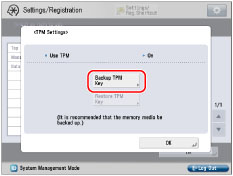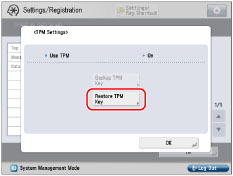 e-Manual e-Manual | Top Site map Site map Help Help |
|---|---|
 Category Top
Category Top Preventing Unauthorized Access
Preventing Unauthorized Access Increasing Security
Increasing Security Restricting Access by Authentication
Restricting Access by Authentication Administrator Settings
Administrator Settings Specifying the System Manager Settings
Specifying the System Manager Settings Department ID Management
Department ID Management Specifying Department ID Management
Specifying Department ID Management Checking/Printing/Clearing Page Totals
Checking/Printing/Clearing Page Totals Accepting Jobs with Unknown Department IDs
Accepting Jobs with Unknown Department IDs Accepting B&W Copy and Print Jobs without Entering a Department ID
Accepting B&W Copy and Print Jobs without Entering a Department ID Specifying Authentication Method for Rights Management Server
Specifying Authentication Method for Rights Management Server Network Security
Network Security IEEE 802.1X Authentication Settings
IEEE 802.1X Authentication Settings Key Pair and Server Certificate Settings for Encrypted SSL Communication
Key Pair and Server Certificate Settings for Encrypted SSL Communication Generating a Key Pair and Server Certificate
Generating a Key Pair and Server Certificate Registering a Key Pair File and Server Certificate File Installed from a Computer
Registering a Key Pair File and Server Certificate File Installed from a Computer Setting the Key Pair Used With SSL Encrypted Communications
Setting the Key Pair Used With SSL Encrypted Communications Editing Key Pairs and Server Certificates
Editing Key Pairs and Server Certificates Registering/Editing a CA Certificate File
Registering/Editing a CA Certificate File Verifying Certificate Validity Using Certificate Revocation List
Verifying Certificate Validity Using Certificate Revocation List IPSec Settings
IPSec Settings Preventing Information Leakage
Preventing Information Leakage Digital Signatures
Digital Signatures Setting/Confirming a Key Pair and Device Certificate
Setting/Confirming a Key Pair and Device Certificate Checking a Device Signature Certificate
Checking a Device Signature Certificate Setting a Rights Management Server
Setting a Rights Management Server Copy Set Numbering Options
Copy Set Numbering Options Restricting the Send Function
Restricting the Send Function Setting the Address Book
Setting the Address Book Mail Box Settings
Mail Box Settings Specifying Settings for All Mail Boxes
Specifying Settings for All Mail Boxes Specifying the Mail Box Security Settings
Specifying the Mail Box Security Settings Setting the Control Panel Display
Setting the Control Panel Display Specifying Management Settings for the Hard Disk
Specifying Management Settings for the Hard Disk Completely Erasing Unnecessary Data from the Hard Disk
Completely Erasing Unnecessary Data from the Hard Disk Initializing All Data/Settings
Initializing All Data/Settings TPM Settings
TPM Settings Device Management
Device Management Device Information Settings
Device Information Settings Specifying Device Information Delivery Settings
Specifying Device Information Delivery Settings Registering/Deleting/Printing Delivery Destinations
Registering/Deleting/Printing Delivery Destinations Setting Automatic Delivery
Setting Automatic Delivery Setting Manual Delivery
Setting Manual Delivery Setting the Receiving Machine
Setting the Receiving Machine Checking/Printing the Communication Log
Checking/Printing the Communication Log Limiting Functions
Limiting Functions Remote UI
Remote UI Clearing the Message Board
Clearing the Message Board Retrieving Audit Logs
Retrieving Audit Logs Saving a Log of Key Operations
Saving a Log of Key Operations Available Administrator Settings Table (Touch Panel Display)
Available Administrator Settings Table (Touch Panel Display)|
IMPORTANT
|
|
Before the TPM setting is activated, the System Manager must check that the default settings of the System Manger ID and System PIN (System Manger Settings) are changed. If the default settings of the System Manager ID and System PIN are not changed, user other than the administrator can backup and the TPM backup key may be taken. Since TPM key can only be backed up once, you cannot restore the TPM key.
Backup the TPM key immediately on to the USB memory after the TPM setting is activated.
For security reasons, you can only backup the TPM key once. Store the USB memory with the backup data in a safe place. Also, write down the password set when backing up and keep it in a safe place.
The security provided by TPM does not guarantee complete protection of the data and hardware. Note that Canon will not be liable for any failure or damages resulting from the use of this mode.
Insert the USB memory straight into the USB port. If the USB memory is inserted in an angle or if you insert a USB memory type not compliant with USB standard, the USB port may be damaged.
Do not remove the USB memory during backing up or restoring data. Doing so may cause damage to the USB memory, USB port, or the data inside of the USB memory. Also if the USB memory is removed when restoring, the machine may be damaged.
|
 (Settings/Registration).
(Settings/Registration). |
NOTE
|
|
If the TPM setting is activated, it may take longer to start the machine.
|
 (Settings/Registration).
(Settings/Registration). 
|
IMPORTANT
|
|
Before backing up, make sure that writing is allowed for the memory media connected to the machine.
Do not connect any other memory media.
|
 (Settings/Registration).
(Settings/Registration). 
|
IMPORTANT
|
|
Before restoring, make sure that the memory media you used for backing up is connected to the machine.
Do not connect any other memory media.
|
|
IMPORTANT
|
|
Restoring of the TPM key recovers access to the HDD/SRAM that became inaccessible due to TPM chip failure, and does not recover the HDD/SRAM itself.
If initialization is performed following the steps for "Initializing All Data/Settings," all of the data encrypted by the TPM key is completely erased and the TPM setting becomes inactive.
For the backup of the TPM key, it is recommended that you use a USB memory with free space of 10 MB or more.
You can use the USB memory that is commercially available.
The FAT32 file system is supported for USB memory.
The following USB memory and usage are not supported.
USB memory with a security function or a memory card reader that connects via USB
Using the USB memory with an extension cable
Using the USB memory via a USB hub
USB memory not compliant with the USB standard
You may not be able to use properly, depending on the USB memory you are using.
When you are using USB memory, the machine cannot enter the Sleep mode. Also, the Auto Sleep Weekly Timer settings are ignored.
You cannot access the machine during backing up or restoring data in the USB memory.
The data on the machine is backed up on the USB memory after it has been encrypted. You cannot manage or browse the backed up data on the computer.
You cannot back up the TPM key for the following cases:
USB memory is write protected
USB memory is not connected
More than one USB memory is connected
Not enough free space in the connected USB memory
TPM key does not exist on the machine
You cannot restore the TPM key for the following cases:
USB memory is not connected
A TPM key does not exist on the USB memory
The TPM key on the USB memory is not correct
|
|
NOTE
|
|
The setting is effective only after you restart the machine (the main power switch is turned OFF, and then back ON). For instructions on restarting the machine (turning the main power switch OFF, and then ON), see "Main Power and Energy Saver Key."
|